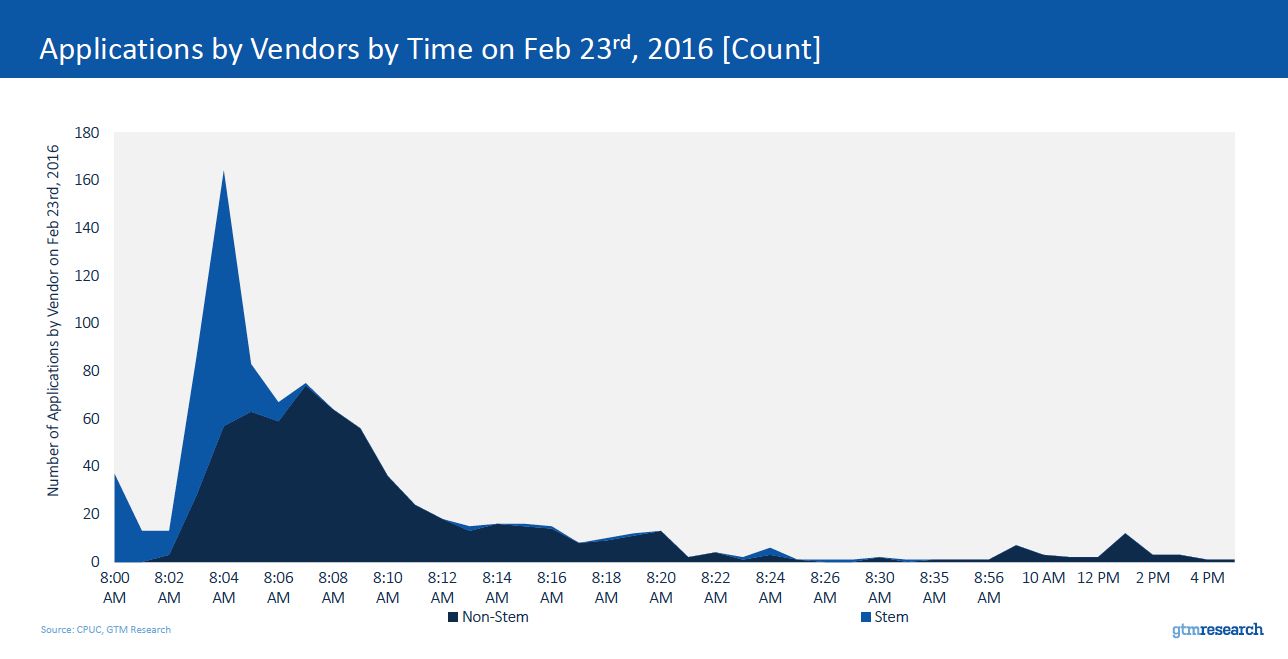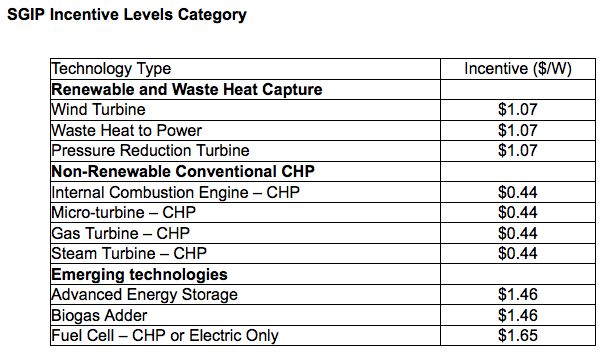On occasion, we've referred to California's Self-Generation Incentive Program, an $83 million per year renewables incentive, as poorly structured.
Today we're adding "poorly administered" to our list of descriptors.
Cutting to the chase -- according to numerous sources, a single company, Stem, was able to secure the first 56 applications in a recent solicitation. According to another reliable source, based on SGIP data, Stem was able to monopolize the online submission process for the first 2 or 3 minutes of the live opening. These sources have suggested that, somehow, Stem might be gaining an advantage in the submission process.

Source: GTM Research
According to a letter obtained by GTM dated March 9, 2016 and addressed to Mr. Edward Randolph, Energy Division Director at the California Public Utilities Commission, a who's who of energy storage companies (SolarCity, Advanced Microgrid Solutions, Avalon Battery, Clean Energy Storage, Enphase Energy, Geli, Gexpro, Johnson Controls, JuiceBox Energy, Sharp Electronics, Sonnen, SunEdison) listed the failures in the SGIP program opening.

(Energy Solutions is the third-party web portal administrator.)
Some of the failures encountered when the parties attempted to access the portal:
- Facing a 3- to 5-minute delay after submitting login credentials
- Receiving an error message when going to the selfgenca.com website and never even getting to the portal login landing page
- The order in which the applications were submitted does not match the time stamp order on the released SGIP data
On February 23 at 8:57 a.m., an email was sent by Energy Solutions that stated: "Due to the high volume and concentration of submissions, some applications received the same 4-digit app number at the end of their application ID."
The letter to the CPUC states, "These are not duplicates but rather applications that were received within milliseconds of each other." The letter adds that what's needed is the design of a "high-functioning program that is no longer dependent on a 'first come, first served' time-stamped ranking methodology" and "measures to ensure funding is more equitably dispersed utilizing an appropriately set developer cap or similar means that ensures diverse participation."
The letter calls the results of the opening "suspicious and concerning" because:
- "Despite the login delays experienced by others, one party was able to submit 56 applications before any other parties were able to submit even a single application (or in many cases, long before other users were even able to log-on)." One would imagine that the CPUC program administrators would notice such a glaring anomaly.
- ~41 percent of the funding was allocated to a single party
- ~70 percent of the funding will be to three parties
The Energy Solutions portal webpage includes a pretty standard restrictions-of-use boilerplate: "[An applicant] may not use any robot, spider or other automatic device, process or means to access, retrieve, scrape, reverse engineer, compile, create derivative works, publicly display or otherwise distribute any portion of the Site or the Platform."
The letter continues, "Currently, the success or failure of SGIP applications appears to be based on the difference in nanosecond application submission time stamps, which raises the specter of potential system gaming. Instead of funding the best and lowest-cost technologies across a diverse range of participants to the benefit of the broader storage market and in the public interest, SGIP is inexplicably rewarding creative and aggressive application submittal strategies and ultimately concentrating funding among a very small pool of applicants."
Stem's Director of Policy Ted Ko had this response:
- Our top priority was to understand the new SGIP portal. We thoroughly studied the SGIP Handbook and portal instructions to make sure our process followed all rules and regulations. We also reviewed all of our procedures with outside counsel to confirm we were in full compliance. We did not use any means to influence the operation of the site or other applicants’ submissions in any way. The results reflect the outcome of our focused efforts.
- There was no gaming, hacking ... and we did not have any information or technical advantage that was not available to any other company. The fact is that the SGIP portal performed better than any previous system had.
- Stem submitted more than twice as many applications as any other company in 2016, and 30 percent of all submitted applications, so it is not surprising that this was reflected in the amount of projects accepted. The results of this process were also completely in line with the historical norm. Since 2011, the top SGIP winner in each program year has hit the 40 percent cap for total dollars awarded and the top three winners have captured an average of more than 70 percent of the funds each year. For this submission, Stem’s expected reservations based on timestamps would also amount to about 40 percent.
- Rapidly growing demand for advanced energy storage has far outstripped available funding, meaning that some number of customers, developers and manufacturers will always be dissatisfied with the results -- and Stem is no exception. Despite our large customer demand, we obtained a very small number of reservations in 2015. The resulting pent-up customer demand for our systems prompted us to file submissions for more than 250 individual customer projects in 2016, some of which had been waiting more than a year.
- It’s important to note that although others have historically secured more reservations for larger dollar amounts, Stem has successfully interconnected more non-residential storage systems under the SGIP program than every other provider combined -- 128 projects, compared to 114 for all others as of January 4. The next highest is Tesla with 49.
- Overall, the move to the portal eliminated many of the pain points created by the email-based process of the past. Unlike previous processes, the server did not crash, and it did not allow the submission of duplicate applications. The next step is for the industry to work together to see that the SGIP program is adequately funded, more along the lines of the California Solar Initiative, which helped incubate the solar industry to the point where technology incentives are no longer needed.
One of the signees of the letter to the CPUC suggested that the storage incentive for individual projects be lowered so that SGIP funds could be used to back a larger number of projects.
The letter to the CPUC concludes that the program is not "functioning in the public interest," adding, "Immediate reforms are needed to fix this flawed program design."
***
Some info on the SGIP program:
The SGIP is the original California renewables incentive, predating the California Solar Initiative.
Bloom Energy's natural-gas-powered fuel cells have drawn or reserved more than $400 million of the program's 14-year $1.4 billion total, according to the CPUC's SGIP worksheet. If the SGIP's aim was to provide several hundred million dollars to a single VC-funded fuel-cell company, then it has succeeded -- by classifying fuel cells as an "emerging technology."

Source: Base SGIP Incentive Levels for Eligible Technologies (from 2015 SGIP Handbook)
However, the SGIP was actually intended "to provide incentives for any distributed generation resources that the commission determines will support the state's goals for reductions of emission of greenhouse gases."



